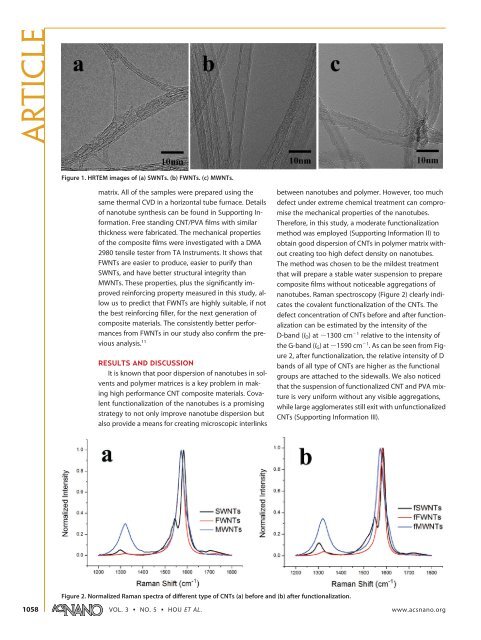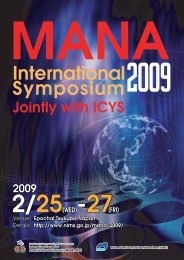Y. Hou, J. Tang, H. Zhang, C. Qian
Y. Hou, J. Tang, H. Zhang, C. Qian
Y. Hou, J. Tang, H. Zhang, C. Qian
You also want an ePaper? Increase the reach of your titles
YUMPU automatically turns print PDFs into web optimized ePapers that Google loves.
ARTICLE<br />
1058<br />
Figure 1. HRTEM images of (a) SWNTs. (b) FWNTs. (c) MWNTs.<br />
matrix. All of the samples were prepared using the<br />
same thermal CVD in a horizontal tube furnace. Details<br />
of nanotube synthesis can be found in Supporting Information.<br />
Free standing CNT/PVA films with similar<br />
thickness were fabricated. The mechanical properties<br />
of the composite films were investigated with a DMA<br />
2980 tensile tester from TA Instruments. It shows that<br />
FWNTs are easier to produce, easier to purify than<br />
SWNTs, and have better structural integrity than<br />
MWNTs. These properties, plus the significantly improved<br />
reinforcing property measured in this study, allow<br />
us to predict that FWNTs are highly suitable, if not<br />
the best reinforcing filler, for the next generation of<br />
composite materials. The consistently better performances<br />
from FWNTs in our study also confirm the previous<br />
analysis. 11<br />
RESULTS AND DISCUSSION<br />
It is known that poor dispersion of nanotubes in solvents<br />
and polymer matrices is a key problem in making<br />
high performance CNT composite materials. Covalent<br />
functionalization of the nanotubes is a promising<br />
strategy to not only improve nanotube dispersion but<br />
also provide a means for creating microscopic interlinks<br />
Figure 2. Normalized Raman spectra of different type of CNTs (a) before and (b) after functionalization.<br />
between nanotubes and polymer. However, too much<br />
defect under extreme chemical treatment can compromise<br />
the mechanical properties of the nanotubes.<br />
Therefore, in this study, a moderate functionalization<br />
method was employed (Supporting Information II) to<br />
obtain good dispersion of CNTs in polymer matrix without<br />
creating too high defect density on nanotubes.<br />
The method was chosen to be the mildest treatment<br />
that will prepare a stable water suspension to prepare<br />
composite films without noticeable aggregations of<br />
nanotubes. Raman spectroscopy (Figure 2) clearly indicates<br />
the covalent functionalization of the CNTs. The<br />
defect concentration of CNTs before and after functionalization<br />
can be estimated by the intensity of the<br />
D-band (ID) at1300 cm 1 relative to the intensity of<br />
the G-band (IG)at1590 cm 1 . As can be seen from Figure<br />
2, after functionalization, the relative intensity of D<br />
bands of all type of CNTs are higher as the functional<br />
groups are attached to the sidewalls. We also noticed<br />
that the suspension of functionalized CNT and PVA mixture<br />
is very uniform without any visible aggregations,<br />
while large agglomerates still exit with unfunctionalized<br />
CNTs (Supporting Information III).<br />
VOL. 3 ▪ NO. 5 ▪ HOU ET AL. www.acsnano.org















